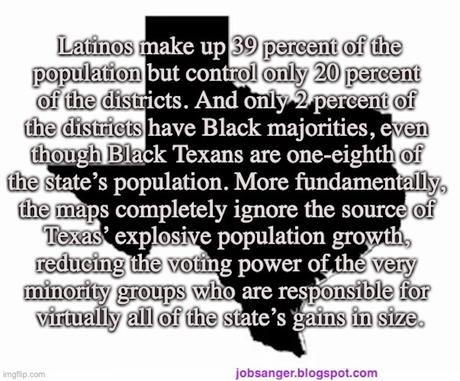
Texas gained enough population between 2010 and 2020 to give it two more seats in the U.S. House of Representatives. About 95% of that population gain was due to minorities. Texas Republicans ignored this, and created two more white seats by dividing minority communities and putting them into majority white districts. This was racist and unfair, and the Department of Justice is suing the state to rectify the situation.
Here is part of how Steve Vladeck describes the Texas unfair redistricting at MSNBC.com:
The Justice Department sued Texas on Monday, challenging its newly drawn electoral maps at both the state and congressional levels. At its core, the lawsuit claims that Texas’ new maps discriminate against the state’s “growing minority electorate.” And clearly, they do. The problem with the lawsuit is not its factual premise; it is the significant steps the Supreme Court has taken in the last eight years to make it easier for conservative states to get away with exactly such anti-democratic (and anti-Democratic) manipulation.
And although Congress could fix much of the damage the Supreme Court has caused, its efforts to do so remain mired in Senate Democrats’ inability to overcome or eliminate the filibuster. Simply put, the latest front in the battle between the Biden administration and Texas reinforces just how fragile our democracy is becoming — and how directly the Supreme Court is responsible.
Texas fared well in the 2020 census: The second-largest state added 4 million residents between 2010 and last year’s count. Most of that growth came from minority groups, which now constitute a majority of the state’s population. Indeed, the statewide population of “Anglos” (non-Latino white Texans) was responsible for only 5 percent of that growth. Among other things, this population boom netted Texas two new seats in the U.S. House — it will now elect members from 38 districts, second only to California.
When the Texas Legislature met to redraw both the U.S. and state house districts in response to the new data, it adopted maps that, put most charitably, do not reflect the actual sources of population growth. As the Justice Department’s lawsuit explains, the two new congressional seats both have Anglo majorities; a West Texas district with a large Latino population was redrawn to turn a Latino majority into a minority, and minority communities in the Dallas-Fort Worth metroplex were, in the Justice Department’s words, “surgically excised” by being attached to different districts with Anglo majorities — some stretching over a hundred miles from Dallas-Fort Worth. And the redrawn lines in the state House are even more, shall we say, aggressive.
The unabashed goal of this gerrymandering was to entrench as large a Republican majority as the Legislature could. The FiveThirtyEight redistricting tracker predicts that, with these maps, Republicans would control 24 of the 38 U.S. House seats, or 63 percent of the delegation, and have a good shot at a 25th in a state former President Donald Trump won last year by only 52 percent to 46 percent. That’s achieved by expanding the voting power of non-Latino white voters, who are about 40 percent of the state’s total population but now control 3 of every 5 districts
As Ari Berman has documented, Latinos, in contrast, make up 39 percent of the population but control only 20 percent of the districts. And only 2 percent of the districts have Black majorities, even though Black Texans are one-eighth of the state’s population. More fundamentally, the maps completely ignore the source of Texas’ explosive population growth, reducing the voting power of the very minority groups who are responsible for virtually all of the state’s gains in size.
Before 2013, Texas’ map would never have made it into force. Texas was a “covered jurisdiction” under the federal Voting Rights Act, meaning changes to its districts would need to get “preclearance” from the federal Justice Department. But in 2013, the Supreme Court, in its 5-4 ruling in Shelby County v. Holder, neutered the preclearance requirement by invalidating the formula Congress used to decide which jurisdictions it applied to.
Although the court’s analysis focused on the claim that the formula was outdated (and therefore was unduly harsh to jurisdictions that no longer had demonstrated patterns of discrimination), as the Justice Department lawsuit points out, “in every redistricting cycle since 1970, courts have found that one or more of Texas’s statewide redistricting plans violated the United States Constitution or the Voting Rights Act.”. . .
The Biden administration’s new suit against Texas may be a bellwether. If the Voting Rights Act can no longer prevent a state that gained seats in Congress almost entirely because of minority population growth from redistricting to reduce the voting power of those minority groups, it will be a powerful testament to how much the Supreme Court has denuded that landmark civil rights statute.
That the case has to be filed at all shows how imperative it is for Congress to fix it, even if eliminating the filibuster is the only way to accomplish such reform. So long as these maps remain in effect, they will provide only further evidence of the fragility of our democracy — and how increasingly unrepresentative our “representatives” are.

